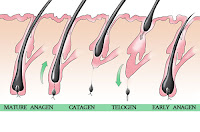James Channing Shaw, MD
Some of the most worried patients in a dermatologist’s practice are those who are losing their hair. The medical term for hair loss is ALOPECIA. The most common type of alopecia is male balding, but there are many conditions that lead to hair loss, some temporary, some permanent. In this post, I discuss only the most common causes.
Hair growth cycles. To understand hair loss, you have to understand hair growth cycles. 80% of hairs on the scalp are in active growth-phase (called Anagen phase), which lasts for years. When growth-phase is completed, the hair stops growing, the root becomes small and round, and the hair goes into a resting-phase (called Telogen phase). After about ninety days in resting-phase, the hair falls out, and a new hair root begins making a new hair. Only 20% of human hairs are in resting-phase at any one time. By comparison, some animals ‘shed’ seasonally because all hairs go into resting-phase at the same time.
Growth-phase (anagen) roots are the ones most vulnerable to illnesses or medications. The prime example is cancer chemotherapy. Chemotherapy destroys rapidly growing cancer cells and growth-phase hair roots get damaged as innocent bystanders.
Androgenetic alopecia. The most common form of hair loss is male pattern balding (medical term: ‘androgenetic alopecia’). It is a genetic response to the male hormone testosterone which men have in abundance and women have in small amounts. Androgenetic alopecia usually happens gradually with no noticeable shedding of hair, just a relentless thinning and shortening of existing hair until (in worst cases) there is complete balding of the top of a man’s scalp. Women with androgenetic alopecia usually do NOT go bald, just thin. The growth-phase hair roots become smaller and smaller over years until they are too small to make visible hair.
 |
| Androgenetic alopecia |
Treatments for androgenetic alopecia. It is now known that the naturally modified form of testosterone called dihydrotestosterone (DHT) is the culprit of androgenetic balding. Without DHT, there is no balding whatsoever in men. (We know this from studying families that cannot make the DHT). Therefore, the drug finasteride (Propecia®) was designed as the first effective drug for male balding because it blocks the conversion of testosterone to DHT. Unfortunately, Propecia does not grow new hair, it merely slows the balding process. In post-menopausal women, sadly, it has very little positive effect.
Minoxidil (a blood pressure drug) was discovered to have the side effect of hair growth, so a topical product Rogaine® was developed which can be a helpful adjunct to treatment but rarely produces a full head of hair. Statistically, about one third of men see benefit after a year, slightly higher in women.
For women with androgenetic alopecia, hormonal treatments are the most effective, though limited. In young women, birth control pills plus antiandrogen drugs (spironolactone) are used together, along with Rogaine® topically. Occasionally Propecia® is added but no large studies have proven its effectiveness in women. In older women, hormone replacement therapy (HRT) plus spironolactone are most commonly used.
 |
| Telogen effluvium |
Chronic telogen effluvium. This is the diagnosis when increased shedding lasts for months. Thinning of total hair mass occurs in worst cases. In young adult women, low iron has long been thought to contribute by triggering growth-phase hairs to convert to resting-phase hairs, and if thirty or forty percent of hairs are constantly in resting-phase, shedding increases, in the shower drain, on brushes, on clothes. Since women lose blood every month with menstruation, and if iron intake is inadequate, healthy growth of hair may be impaired. The diagnosis requires a specific iron test called ferritin which indicates the total body iron stores. The ferritin level should be above 40 for adequate hair growth. Eating more red meat or taking iron supplements can reverse the problem. The iron theory has recently been challenged in new studies, and further investigations are needed.
Many drugs can trigger ongoing hair loss of the ‘chronic telogen’ type. Fortunately it is not permanent, but it is often difficult to identify the medication causing the problem when multiple medications are being given. Stopping or changing medications requires careful monitoring by a physician.
Other diagnoses:
 |
| Alopecia Areata |
 |
| Tinea Capitis (ringworm) |
Lupus. A more severe and different autoimmune disease, Lupus erythematosus can affect hair, leading sometimes to permanent scarring hair loss. Treatments also range from injections to serious immune suppressants.
Natural approaches, vitamins, nutrients. Iron and protein are probably most important. Iron is discussed above. Modern western diets frequently do not have enough protein for healthy hair. While not studied scientifically, individuals should eat three portions of protein per day for optimal hair growth.
Too much vitamin A (greater than 25,000 IU/day) can cause hair loss. Biotin deficiency causes hair loss, and supplementation with Biotin can be beneficial in telogen type hair loss. Research has shown that ingredients in Chinese green tea block 5- reductase and could lessen androgenetic alopecia, although no large scale clinical studies have been done.
Finally, a word on commercial hair care products. There is no hair care product that penetrates deep enough to influence hair growth at the level of the roots. Most products are washed off and even those that remain on the scalp cannot penetrate deep enough to influence the roots. No matter what they claim about roots, hair care products can only affect the shape and texture of existing hair and the top layer of scalp skin. If too harsh, they cause breakage over time.
